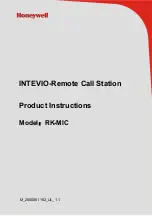
35
Sabine Smart Spectrum
®
Wireless
LIT-SWM6-7000-OG-EN-110203.indd
© 2011 Sabine
, Inc.
11. MuLTIPLE SYSTEMS oPERATIon
11.1. overview
In many circumstances a single wireless microphone system is all that will be
in use at any one time. Larger applications (church, concert hall, theater stage,
conference room, etc), however, can often require a large array of wireless mi-
crophones, all demanding flawless uninterrupted simultaneous operation.
Multiple system operation presents at least two important operational challenges:
interference among transmission channels, and setup complexity. Sabine Smart
Spectrum provides powerful solutions to both, particularly the interference
problems associated with two or more RF channels at work at the same time,
at the same location.
11.1.1. Multiple System Interference
Sabine Wireless addresses multiple system interference with two strategies.
First, greater available bandwidth in the 2.4 GHz and 915 MHz ranges means
more channels can occupy the band, i.e., the expanded range can be divided
into a greater number of separate transmission/reception bands. Second,
with Smart Spectrum transmission and reception, channels are more tolerant
of interference. The net result is that Sabine Wirelss offers the potential for
many more simultaneous transmission channels than conventional UHF or
VHF systems.
While such performance benefits are one of the major advantages of the
SWM, more systems working at the same time leads to a greater potential for
complexity. Fortunately, the SWM6000 and 7000 also offer tools to simplify
setup and operation.
11.1.2. Setup Complexity
Multiple wireless systems in a large installation are of course more compli-
cated than a single transmitter/receiver. More space is needed, and the sheer
quantity of transmitters and receivers that may be in use at a single installation
can prove difficult to manage. The SWM series helps manage such potential
complexity with four strategies and/or system accessories:
1.
First, the dual channel receivers (SW72 and SW62) receivers offer a 50%
space-saving advantage with 2-channel receivers that occupy the same 1U
space as single channel receivers. Each channel in a 2-channel system
shares the true diversity operation of the two antennas connected to the
single receiver chassis.
2.
Second, the optional SWA6SS (six-system antenna distribution amplifier)
greatly reduces the complexities of multiple receiver antenna deployment.
Since each receiver has two (diversity) antennas, which can be mounted
on either the rear or front panel, multiple receivers at one location can
potentially create a forest of antennas protruding from the front or back
of a rack. The SWA6SS Antenna Distributor reduces the number of
antennas to as few as 1/6 what would otherwise be needed. An added
important advantage of using the SWA6SS is its distributed signal boost
provided to all the antenna outputs, delivered while maintaining diversity
in all attached reception channels.
3.
Third, large installations often entail long distances from transmitters
to receivers, or the presence of obstacles (walls, for example) in the
transmission path that can interfere with clear reception. While the
SWM Series series are designed to minimize these kinds of problems
without accessories, the SWASS-EXT (set of two extension antennas,
shown in figure 12b on page 38) may prove helpful or even necessary
in some situations. In addition to providing remote and/or desirable low
profile positioning with improved reception, the SWASS-EXT also adds
significant gain for even more reliable system performance. The Exten-
sion Antenna and Distribution Amplifier components are also designed to
operate in tandem, with the Extension Antenna plugged directly into the
amp, which can then feed (via cable) the antenna inputs of 6 receivers.
A combination of 2-channel receivers, a set (2 pieces) of SWASS-EXT,
and one SWA6SS, would reduce the antenna clutter of 12 transmission
Multiple Systems operation
Содержание SWM6000
Страница 2: ......
















































